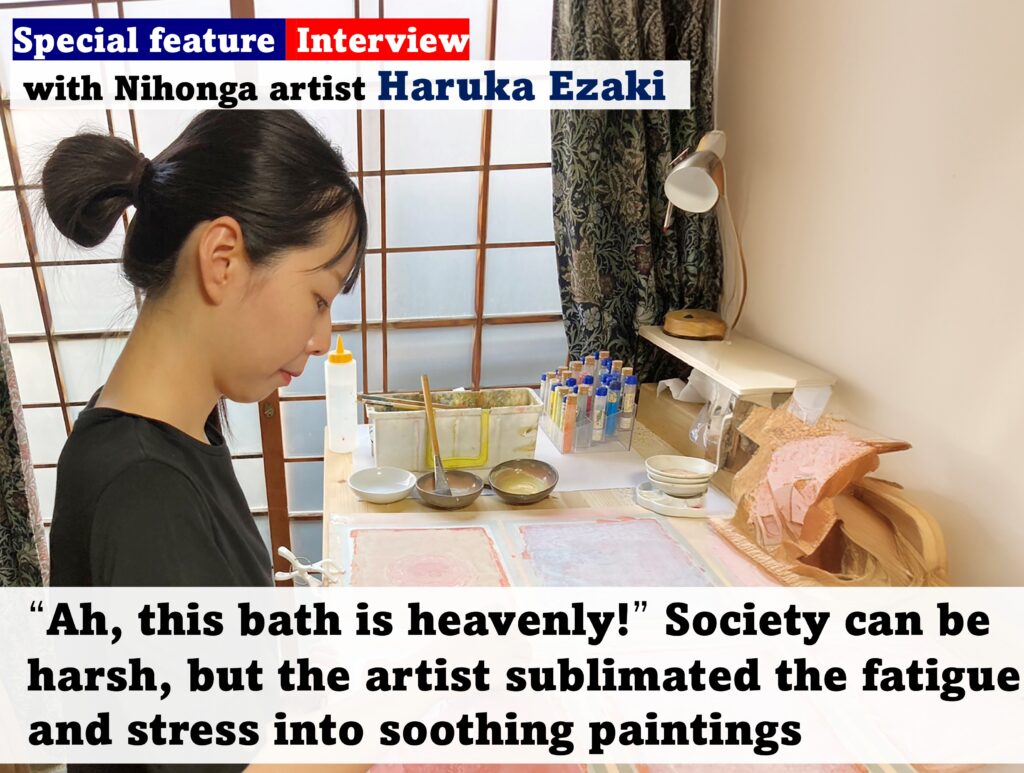
Interview with Nihonga artist, Haruka Ezaki. Please enjoy reading this interview by Imoko Ichinose.
Interview with Nihonga artist Haruka Ezaki
Learning about life from animals

Thank you for taking the time for this interview today. We see a variety of animals and flowers in your paintings. Have you always felt close to them since you were a child?
I have an aunt and uncle in Miyazaki, and remember playing with their Pomeranian every time we went to visit them. I think that’s how I came to love animals. I wasn’t allowed to have a pet, but I was desperate to have one, and one day I was inspired to bring home a goldfish from our local summer festival. That opened the door for me to have pets at home.
How ingenious!

Later, we got a comet goldfish and named him “Akahigemaru” (red beard), who grew to be 25cm long. When he started laying eggs though, I realized that Akahigemaru was actually female.
What a funny story.
I also loved birds and often walked to the local park to feed sparrows and pigeons so that I could see them up close. While I was in elementary school, I remember rescuing an injured baby bird. I was determined to take good care of it and nurse it back to health. One day, I noticed bird poop on the hatchling’s wings and washed it in cold water. It stayed shivering for a long time, and died later that night. I felt so sorry for what I’d done, even though I had the best intentions.
That must’ve been a hard experience for you. Animals teach us the value of life.
Drawing a picture of the movie, Titanic, in kindergarten

Can you tell me what got you interested in drawing?
As a young child, I often drew cartoon or video game characters. In elementary school, I would often get a line of my classmates in front of my desk during lunch time, asking me to draw their favorite cartoon characters. Additionally, one of my favorite scenes from the movie Titanic, is the one where Jack draws a nude sketch of the heroine. I adored that scene and used to pause it and sketch the nude model myself.
You were already making people around you happy through your drawings at an early age. I heard that you won many prizes in art competitions when you were a student. What were your school days like?
In middle school, I joined a sports team, but peer pressure became stressful and I switched to the art club. At the time, I was already a part of an art class in my local community, and I loved it. My friends in the art club and I got along really well, and I was convinced that this is where I really belong.
An era when students were presenting their art to the world – Design major
I went to a public high school following my sister’s footsteps. The school offered a wide variety of classes, and I was able to create my own personal timetable. I even went to an art college for off-campus study. I was fortunate to be in a fantastic learning environment.
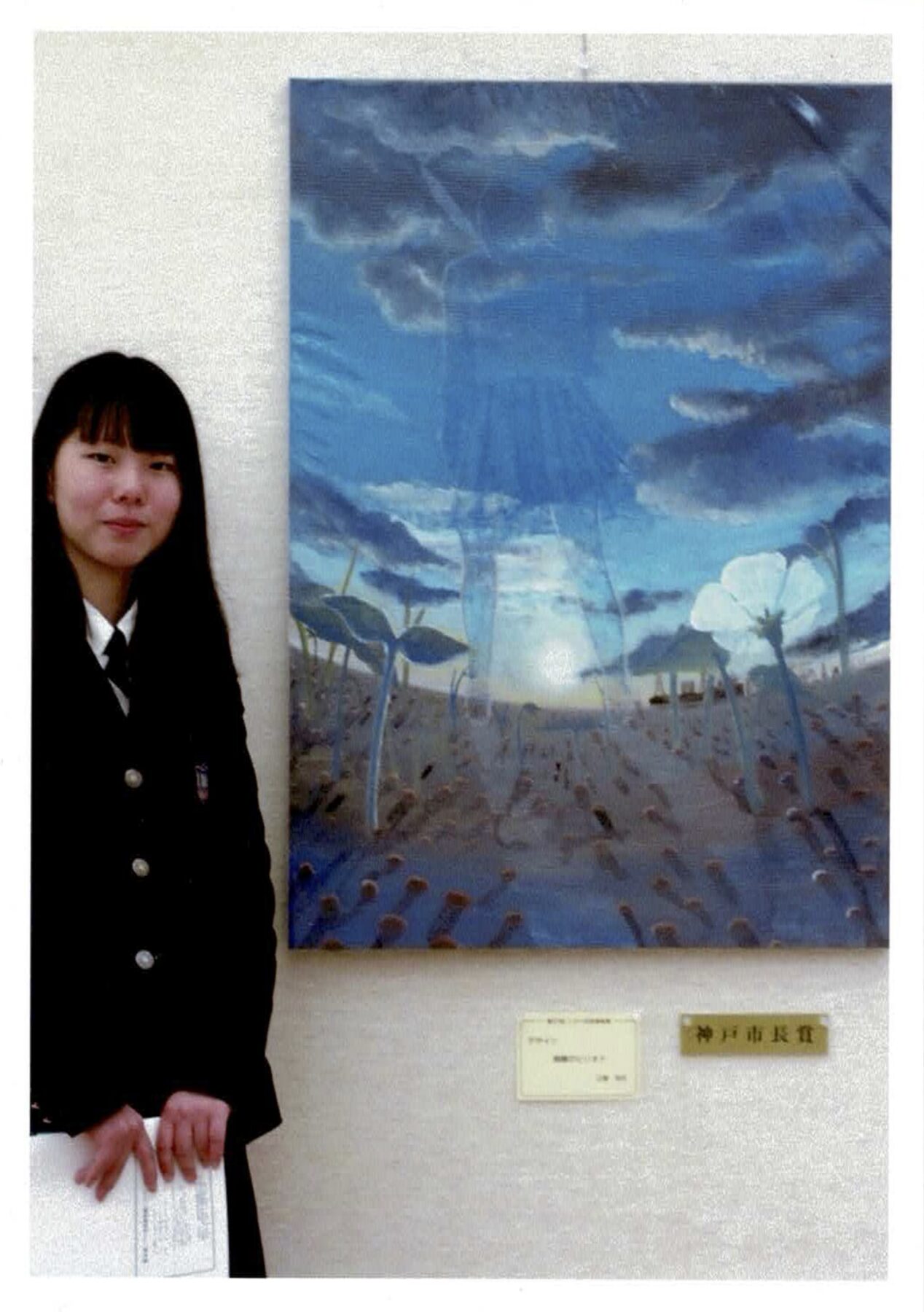
Initially, I thought I wanted to be an architect, because my grandfather was an architect. My high school teacher encouraged me to keep my options open and told me, “You may have a talent for art, so why don’t you study broadly at an art college without narrowing down your choices yet?”. I took their advice and applied into an art department for college, and started going to an art prep school in senior year of high school. I honed my drawing skills there.
That’s why you went to a university with a design department.
At first, I wasn’t sure whether I should major in design or painting. This was around when smartphones were becoming popular in the world, and students were beginning to realize the importance of putting information out into the world in their unique way. I wasn’t very good with computers, so I entered the Visual Arts Course (then called the Illustration Course) at Osaka University of Arts.
You realized the importance of presenting your art to the world in your own unique way, and that became the deciding factor in your career path. What did you study at the university?
In my college classes, I learned not only analog artwork creation, but also digital processing such as book covers and magazine editing, book binding, and many other things such as printmaking, woodwork design, etc. The main part of the training wasn’t to make pictures that express a point, but instead to create illustrations according to a given design theme and layout of the product, etc. The skills I learned through design and digital processing helped me start working in the design field, and I continue to be involved in the design of a quarterly magazine published by a certified non-profit organization.
Painting with materials I’ve never used before, at university
Was it in college that you first started Nihonga?
That’s right. In my junior year in college, we had an assignment to “paint with materials we’ve never used before”. I took on the challenge of Nihonga. I’d previously painted with acrylic gouache and oil paints, but I had absolutely no experience with Nihonga. I read a how-to book in the library and started using suihi-enogu (mud pigment, mainly used as a base coat before applying mineral pigment). I’d never taken classes and was entirely self taught at that point.
Learning Nihonga on your own is a remarkable feat.
I’ve made numerous mistakes and learned from them. I had trouble applying washi properly which caused it to wrinkle, and I also had trouble grasping the characteristics and properties of the paints. It was difficult work, but I also enjoyed the learning and discovery process very much. Unlike the illustration board and fine art paper I’d been using until then, painting on washi softened my expressions. The depth of color and rich gradations that Nihonga materials created was a pleasant surprise.
My instructor at the time told me, “I think the theme of your paintings (the importance of life) complements the painting material”, which stuck with me. That was all the encouragement I needed to continue Nihonga.

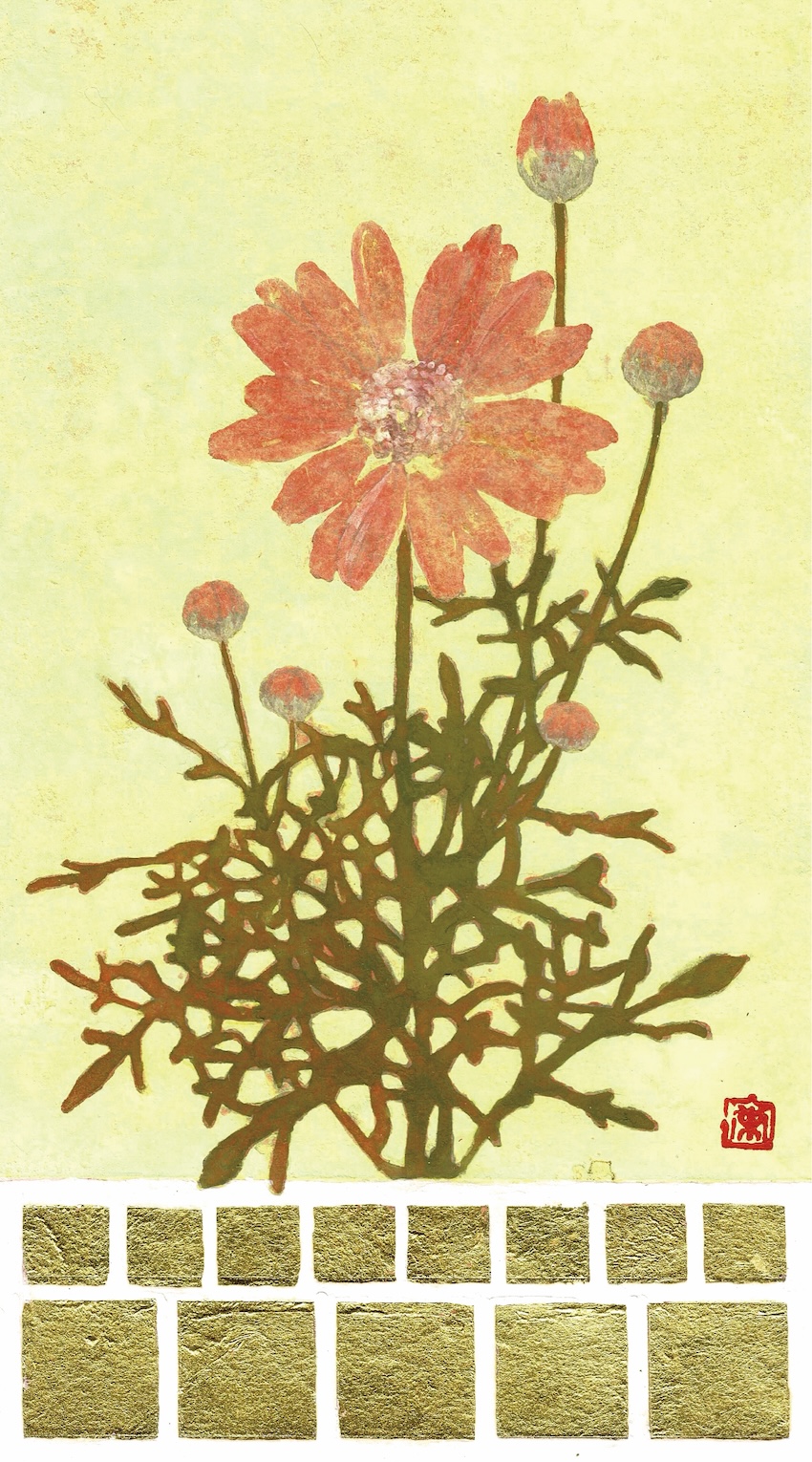
So that’s how you got started in Nihonga. When did you start working seriously as a painter?
Since I started working as a part-time instructor at my alma mater, I’ve gained more time to paint. In 2019, I became a member of the Nishinomiya Art Association, which is when I started to really focus on my paintings.
“Ah, this bath is heavenly!”, Society can be harsh, but the artist sublimated the fatigue and stress into soothing paintings of animals at the bathhouse
Your Nihonga paintings often depict scenes of “animals relaxing in bathhouses”. Is there a story behind this?
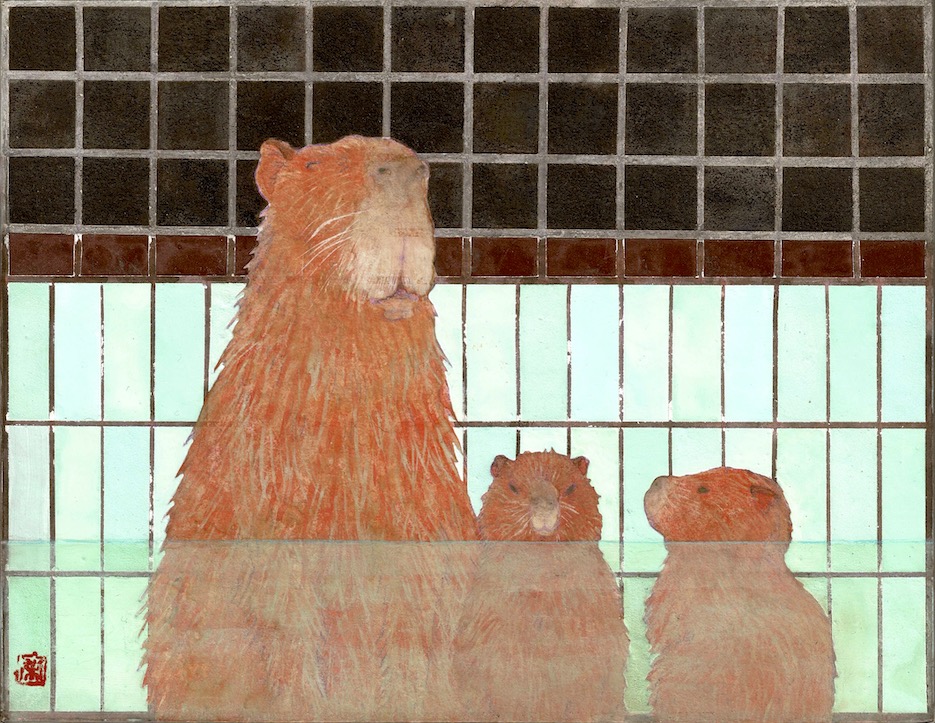
Those are drawings based on my own experiences. When I started working, I learned that society can be harsh. I sometimes felt caught between thinking things like, “everyone else can do it but me” and “I think this is what should be done, but the company disagreed”. I’m sure everyone has probably had similar experiences. I gradually lost confidence and spent days unable to sleep, anxious about the days ahead. That’s when I would escape to the bathhouses.
To the public baths?

That’s right. I went to the public baths on holidays or in my free time. Soaking in the bathtub was a healing experience. The people in the bathhouses might have their own diverse lives, but once they’re there, they let go of the day’s fatigue and worries — or shall we say, “let the water wash their worries away”.
I felt at peace in the tub, thinking to myself “Ah, this bath is heavenly!”. Soaking in the tub of the bathhouse means shedding any pretense and loosening your values as we all become equals as living creatures.

At the end of your daily struggles, you found the public bathhouse.
I prefer painting works that give a viewer strength or provide a sense of calm and peace, rather than drawing to express the hardships and trauma I endured. Everyone goes through difficult times in their daily lives indeed, but the power that baths have to heal us at those times is underrated. That’s why I paint animal parents and their young ones soaking leisurely together and yawning – so that as viewers, we can all relax a little.
That must be why your paintings help me feel relaxed!
Unique style paintings that are self-taught
In your drawings, I sense a unique use of distortion and skillful compositions that could only have come from someone who studied design. The balance between this unique style and traditional Nihonga painting technique is fresh and intriguing. How do you create your paintings?
The first step is to think about the composition. Take the piece Dango-Uo no Natsumatsuri (Summer Festival of the Flying Fish) as an example. It’s composed using collaging methods when thinking about the design.

In this painting, a variety of lumpfish are playing under lanterns. I made separate sketches of fish and lanterns, copied them in various sizes and arranged them in their spots to get the right composition. For me, sea creatures are interesting in their design; they’re much more vibrant than their river counterparts.
You start from the composition. When we take a close look at your work, we can see that the washi is layered on, which creates a soothing effect. Is this technique also self-taught?
I came across the traditional Nihonga technique of layering as a way to enhance depth and dimension, like illustrating how blood vessels can be seen through layers of skin. As I delved deeper, I thought about painting and layering thin washi papers for the colors to show through.
While visiting numerous art supply stores, I learned about a special type of washi, Gampi-shi. Gampi-shi is often used for Koguchi Mokuhan (Japanese wood-engraving technique for carving an image on a section of wood). The paper is so thin that it allows you to see through it. Colors are applied to the first layer of washi, then to the second layer, and so on, to create unique colors. You can add wrinkles to the washi to give it even more expression. In the course of my journey, I’ve learned that there are many methods to create colors that aren’t just mixing paints.
I’ve come to believe that these techniques accurately depict how I want to express my theme — the depth of “life” — in a simple and straightforward way.

“I like the expression on this sparrow’s face” – sharing a moment with new customers

Do you remember the reason you made your debut as a painter in 2022?
My high school teacher had a relative who was a painter by profession, and they got me in touch with an art dealer. I was able to hold my first solo exhibition in 2022 and make my debut in Takatsuki-shi, which is close to my hometown in the Kansai region. Holding a solo exhibition was a huge step for me.
What experience did you gain from your first solo exhibition?
Some attendees who I’d never met before told me that they’d seen my work on a postcard of the exhibition sent by a department store, and were keen to come see it in person. One visitor said “I like the expression on this sparrow’s face”, and bought my work.
Experiencing this exhilarating feeling, knowing that someone I didn’t know before appreciates my paintings, is something I don’t think I’ll ever forget.
Connecting with fans through Nihonga, and giving picture books a try
Now that you’ve made your debut as an artist, can you tell us about your future aspirations?
I’d like to hold exhibitions in Tokyo and in other cities throughout Japan. I plan to continue painting and exploring new methods. Most of all, I hope to make paintings that will make the viewers feel “invigorated” or “relaxed”.
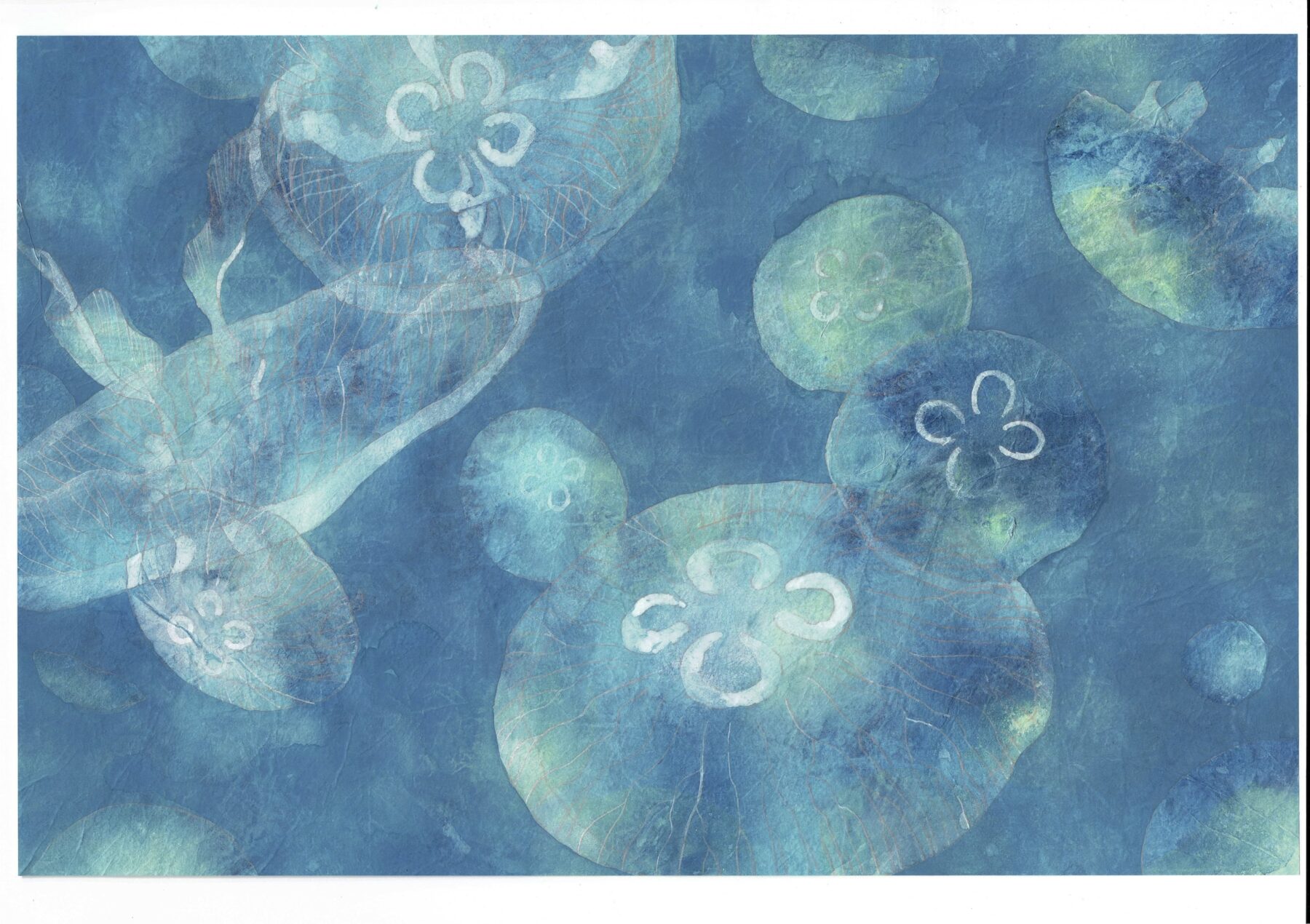
My other dream is to publish a picture book. In the same year as my first solo exhibition, I entered in the Bologna International Picture Book Original Drawing Exhibition in Italy for the first time, and was selected as one of the finalists (318 people) out of more than 3,800 entries from 92 countries. I’d like to make more picture books in the future, along with Nihonga painting of course.
That’s a great dream to work towards. I look forward to seeing more of your works in the future!
(interviewed and written by Imoko Ichinose)
Haruka Ezaki, artist bio

2017 Graduated from Osaka University of Arts
2022 Solo Exhibition, Takatsuki Hankyu
2023 Solo Exhibition, Hanshin Nishinomiya
2023 Solo Exhibition, Takatsuki Hankyu
2024 Solo Exhibition, Isetan Urawa
Description of Haruka Ezaki’s work Nukumori (Warmth)

The painting is of a Pomeranian father and son soaking in a bathtub. The puppy is completely absorbed with its floatie and is adorable. Haruka Ezaki, who majored in design in college, excels at distortion and paints lovable animal figures with such gentleness. Her use of Nihonga Iwa-Enogu (mineral pigments) is an important component of her warm and gentle philosophy of life.
When she first entered the workforce, she couldn’t help but feel the harshness of society, and sometimes went to public baths (Sento) to relax her tired body and mind. Sento, where people across all ages and skin tones share their leisurely time together, became a motif that represents peace to her.
The meaning of “nukumori (warmth)” varies depending on the viewer, which is the perfect word for her worldview that warmly embraces a wide range of values.
(Description by FFD)
Details of Rie Saito’s exhibition
Coming soon.
